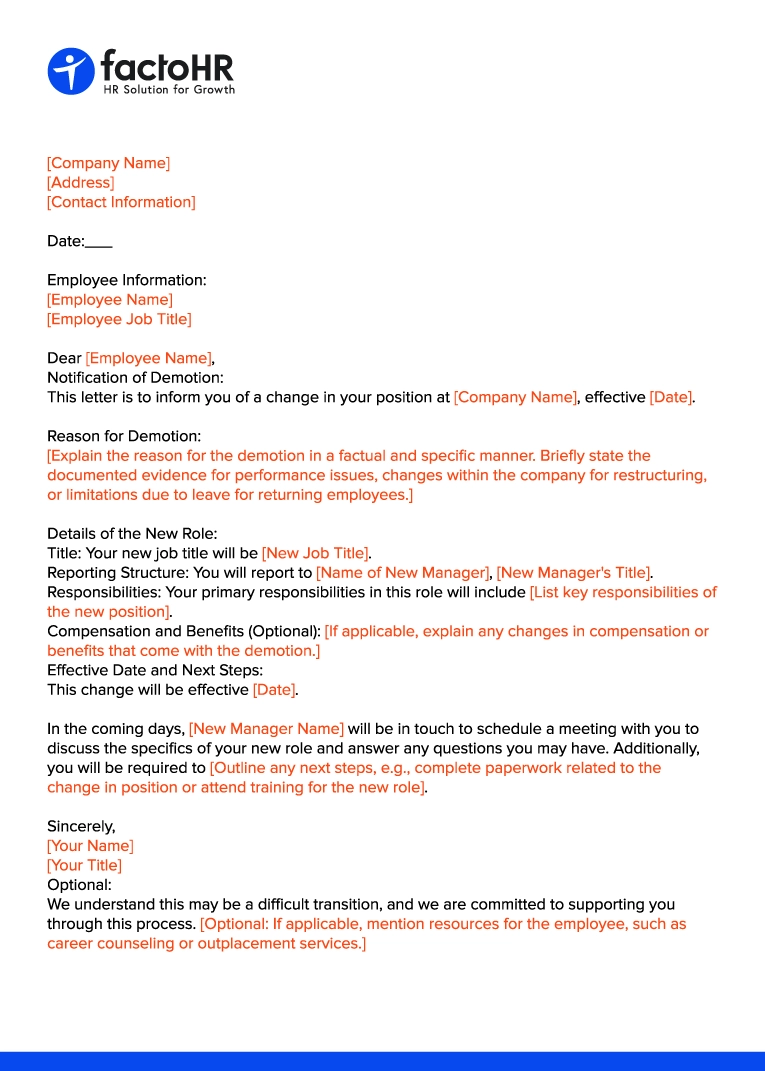Demotion Letter: How to Write, Template, and Samples

Table of Contents
A demotion letter tells an employee in writing that their job is changing. This usually means they will have less to do, a lower-ranking position, and sometimes less pay. This change might happen for different reasons, like not doing well at work, the company reorganizing or taking a long break.
For HR professionals, it is crucial to handle a demotion sensitively and communicate clearly, ensuring that the employee understands what is happening and feels respected throughout the process. In this blog, we’ll explore the essentials of drafting a demotion letter, including when to use it, how to structure it, and best practices for delivering the news with sensitivity and clarity.

What Is a Demotion Letter?
A demotion letter is a formal document that notifies the employee that their present position within the company has changed. This results in a decrease in their responsibilities, power, and even compensation. It operates as an official record that suggests the employee will perform new duties and there will be a change in their responsibilities.
Importance of Considering Alternatives
Demoting an employee is never on the priority list for an employer as it brings many challenges for both. There can be several alternatives to address performance issues or company restructuring needs:
Performance Improvement Plans (PIPs)
A formal plan comprising set goals, timelines, and support resources can be established to empower employees to improve their performance.
Training and Development Opportunities
Developing training programs can be helpful if the employee lacks skills that can be obtained through proper training. This will eliminate the need for relegation.
Reassignment to a Different Position
If an employee’s skill set matches other positions within the company, reassigning can be a better option.
Demotion Letter Format

When Is a Demotion Letter Used?
There are several scenarios where a demotion letter might be necessary:
Performance Issues
When performance is constantly declining, or a skill gap hampers output, a demotion can be the measure taken. This will allow them to refocus on what needs to be done and how to escalate for improvement, eventually leading to better results.
Company Restructuring
Organizations must restructure after mergers and downsizing. This scenario may lead to demotions to different positions rather than confronting termination.
Redundancy
When a specific role no longer exists due to technological advancements or business variations, it will result in demotion to a different position in the company.
Returning From Leave
Extended leave may cause a gap in the workflow, and sometimes, it becomes difficult to gain the same pace in work after rejoining. To overcome this situation smoothly, the employee may be demoted to a lower position with less responsibility.

How to Write a Demotion Letter
Structure and Tone
Writing a letter of demotion is like delivering bad news to employees. So, tone plays a vital role, and it needs to be professional and respectful. Here’s how to achieve that:
- Use formal business language throughout the letter. Avoid using slang or casual expressions.
- Maintain a neutral tone based on facts and objective observations.
- Avoid unnecessary elongation and keep the letter concise and to the point.
- Provide an apparent reason for the relegation and details of the new role.
Standard Structure
A well-structured demotion letter follows a precise format as follows:
- Add the employee’s name, date, and your name/title at the top of the letter.
- Begin with a clear statement informing the employee of the decision to demote them.
- Justify the reason for the demotion in a factual and precise manner. Some reasons include skill gaps, performance issues, company restructuring, and internal role changes.
Details of the New Role
Outline the details of the new position as follows:
- Specify the new job title.
- Specify who the employee will report to in their new role.
- Summarize the responsibilities aligning with the new position.
Effective Date and Next Steps
Mention the effective date during the demotion. Guide the employee through their next step, including a new manager, a change in position, paperwork, and whether any training is required for a new role.
Closing
End the letter with a professional closing and your signature (if sending a physical copy).
Delivering the Bad News (Reason for Demotion)
A situation like demotion needs to be handled delicately, but explaining the reason for the concern is essential.
Specificity and Factual Basis
Evidence and specific details should be provided to support your decision. This could involve identified gaps in skill observed during training assessments with necessary documentation and an exponential decline.
Avoid Accusations or Attacks
Personal attacks should be avoided, as they shatter an organization’s values rather than focus on objective reasons.
Transparency and Opportunity for Understanding
Employees have the right to know the reason for demotion, which can help them improve in the future.
Details of the New Role
The letter should clearly define the new role:
- The job description should be outlined clearly, along with the expectations.
- Specify who the employee will report to in their new role.
- Explain the benefits or changes in compensation, if applicable.
- You can also mention an improvement path that could help employees quickly regain their positions with improved skills.
Resources for the Employee
In some situations, you might consider offering resources to support the employee during this transition:
- If appropriate, you can offer access to career counseling services to help the employee navigate their career path.
- Assist the employee with job search in case outplacement services are offered.

Demotion Letters Templates for a Variety of Circumstances
While the core structure of a demotion letter remains consistent, the specific content can vary depending on the reason for the relegation. Here are some examples of relegation letters tailored to different situations:
1. Performance Issues
This is a common scenario for demotions. The letter should clearly outline the documented performance issues that led to the decision. Here’s an example:
Dear [Employee Name],
This letter informs you of a change in your position at [Company Name], effective [Date]. Due to documented performance issues in your current role as [Current Job Title], we have decided to demote you to the position of [New Job Title].
During your recent performance reviews, we identified areas for improvement, including [List particular areas of performance deficiency]. Despite efforts to address these concerns through [Mention previous attempts to improve performance, e.g., coaching, training], we have yet to see the desired progress.
Your new role as [New Job Title] will involve [Briefly outline responsibilities of the new role]. This position better aligns with your current skill set and provides an opportunity to demonstrate improvement in areas of [Mention specific areas for improvement].
We are confident that, with dedication and focus, you can regain your previous position. In the meantime, [New Manager Name] will schedule a meeting with you to discuss the details of your new role and any available training opportunities.
Please don’t hesitate to contact HR or your new manager with any questions.
Sincerely,
[Your Name]
[Your Title]
2. Company Restructuring
During restructuring, some roles might become redundant, requiring demotions. The letter should explain the change and offer support for the transition. Here’s an example:
Dear [Employee Name],
As you know, [Company Name] is undergoing a restructuring to adapt to changing market conditions. As a result, the department of [Department Name] is being restructured, and your current role as [Current Job Title] will no longer exist after [Date].
However, we value your contributions to the company. We are pleased to offer you the opportunity to transition to the position of [New Job Title] within the [New Department Name] department, effective [Date]. While this position represents a demotion regarding title and responsibilities, your salary will remain unchanged at [Current Salary].
We understand this change might be unexpected. [New Manager Name] will contact you to discuss the specifics of your new role and answer any questions you may have. We are committed to supporting you through this transition and will provide any necessary training to ensure your success in your new position.
Sincerely,
[Your Name]
[Your Title]
3. Returning From Leave
An employee returning from extended leave might be unable to resume their previous role due to limitations. Here’s an example of a demotion letter in this scenario:
Dear [Employee Name],
Welcome back to [Company Name] after your leave of absence. We’re glad to have you return.
During your absence, some changes have occurred within the [Department Name] department, including [Briefly explain any changes within the department]. Due to these changes and [Explain limitations due to leave, e.g., health restrictions], it would be better to transition you back to your previous role as [Current Job Title].
However, we’d like to offer you the opportunity to return to work in the position of [New Job Title], effective [Date]. This position provides a smoother transition back into the workforce and allows you to utilize your skills in [Mention relevant skills]. The responsibilities of this new role include [Briefly outline responsibilities].
This may require some adjustments. [New Manager Name] will meet with you to discuss the details of your new position and answer any questions you might have.
Sincerely,
[Your Name]
[Your Title]
By tailoring the demotion letter to the specific context, you can deliver the news with greater sensitivity and clarity for the employee.

Delivering the Demotion Letter
The Importance of a Face-to-Face Meeting
Unlike any other letter, a letter of relegation is complicated to deliver. It is better to give it in person during a face-to-face meeting; it is a more humane approach than sending it via email or any impersonal method.
- A personal intervention helps you evaluate the employee’s reaction and offer emotional support.
- The employee can ask questions about all the doubts associated with the decision, thus facilitating a two-way conversation.
- Delivering the news face-to-face can create a more professional atmosphere as the probability of miscommunication decreases.
Conducting the Meeting Respectfully
Here are some tips for conducting the demotion meeting professionally and respectfully:
- During the meeting, keep a clear mindset of what needs to be said and be precise with the words. There will be questions, so have answers ready.
- Choose a quiet, private location where the conversation will remain uninterrupted and confidential.
- The situation is challenging for an employee to accept, so be empathetic and acknowledge the employee’s feelings.
- Use the demotion letter as a reference and explain the reason for the relegation.
Handling the Employee’s Reaction
A letter of demotion will elicit a range of emotions in the employee. Be ready for:
- Acknowledge their anger and allow them to express their frustration. Remain calm and avoid getting defensive.
- Emphasize the company’s desire to see them succeed and explore any potential opportunities for improvement within the new role.
- Answer their questions regarding the new position and their job role.
Active Listening and Empathy
- Be genuinely interested in understanding their viewpoint by practicing active listening.
- Show empathy for their situation and acknowledge the challenges associated with the demotion.
Maintaining Confidentiality
It’s crucial to maintain confidentiality throughout the demotion process.
- Share this information only with those directly involved (employee, HR, new manager).
- Refrain from disclosing this to colleagues or other departments.
- Concerns about gossip might arise, but ensuring employee confidentiality and emphasizing the importance of a professional transition is essential.
By following the above steps of delivering the relegation letter, the negative impact on the employee can be minimized, and their dignity can be maintained.
Legal Considerations for Demotion
It is essential to consider all the risks related to legal effects before finalizing a demotion.
Following Company Policies
The relegation process is bound to the company’s policies. The procedure from start to finish should be followed.
Documentation
Before executing the demotion, be thorough about the issues related to performance and misconduct and address the situation by maintaining proper documentation.
HR and Legal Counsel
Before demoting an employee, consult HR and legal counsel to ensure compliance with employment laws and company policies.
Conclusion
Demotion is stressful, so several aspects must be considered while delivering a demotion letter. It should be done with clear communication and face-to-face. State facts respectfully and ensure that the employee understands the company’s decision. Prioritize their well-being by being empathetic towards the employee.
You should also conduct the meeting respectfully and privately to maintain employee dignity. Do not involve many people. Offer support like career counseling; this might help them regain their position in the future.

Frequently Asked Questions
When Is a Demotion Letter Used?
A demotion letter notifies the employee that their current position within the company has changed, resulting in decreased responsibilities. This step is taken if performance issues, redundancy, or when an employee returns from extended leave.
What Should Be Included in a Letter of Demotion?
A well-structured letter of demotion should include:
This section provides employee information, notification of demotion, the reason for demotion, details of the new role, effective date, and next steps.
How Should a Letter of Relegation Be Delivered?
Unlike any other letter, a letter of relegation is hard to deliver. It is better to give it in person during a face-to-face meeting; it is a more humane approach than sending it via email or any impersonal method.
What Are Some Legal Considerations for Demotions?
It’s crucial to ensure the demotion process complies with company policies and procedures regarding employee discipline and changes in position. Document performance issues or misconduct. Consulting with HR and legal counsel helps minimize the risk of legal challenges.

Modernize your HR tasks with factoHR today
Experience the digitalization of everyday business activities with factoHR's modern and compatible solutions for every need.

© 2025 Copyright factoHR


